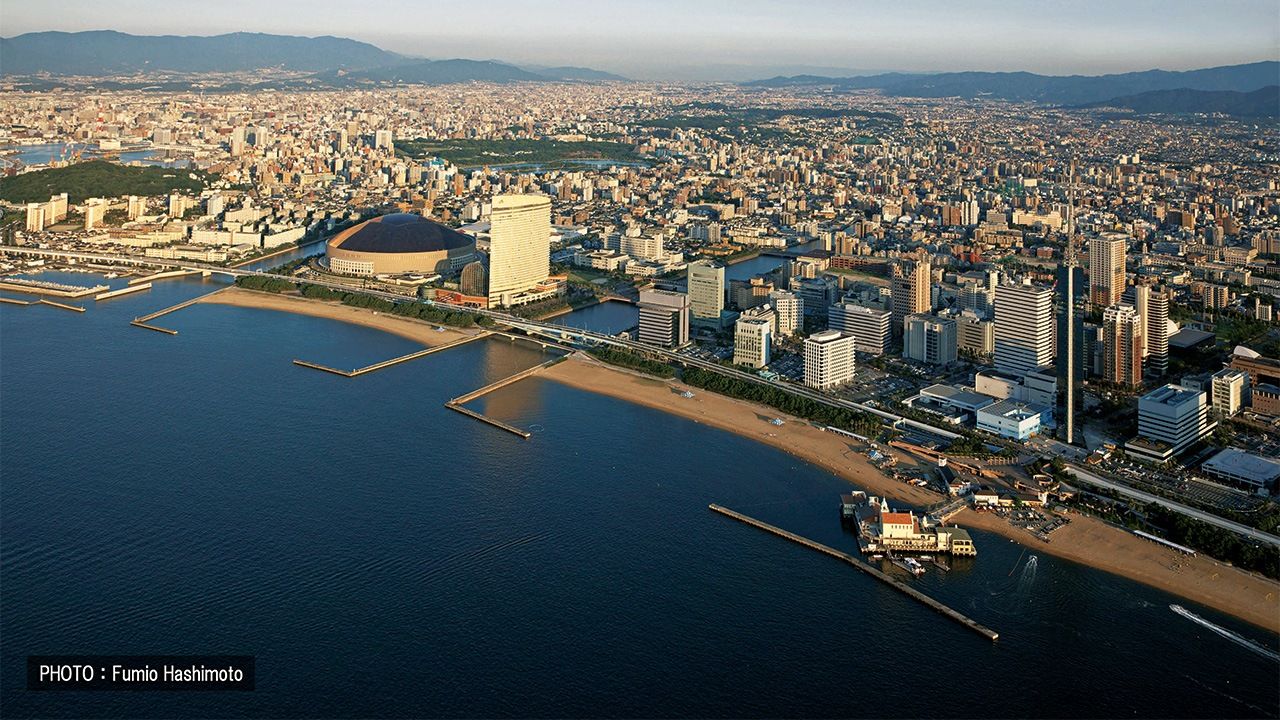
Fukuoka: Kyūshū’s Asian Gateway Adds Fresh Layers to a Long History
History Society Culture Travel- English
- 日本語
- 简体字
- 繁體字
- Français
- Español
- العربية
- Русский
The city of Fukuoka is one of Japan’s most energetic regional centers. A February 2020 estimate puts the population at 1.60 million, making Fukuoka the fifth most populous of Japan’s major cities, and it enjoys a rate of municipal population growth surpassed only by Kawasaki. As Japanese society as a whole grapples with the serious issues of a low birthrate and an aging population, the growth strategy formulated by the city of Fukuoka to counter this trend focuses on the revitalization of the region through support for start-ups, tourism, and MICE (meetings, incentive travel, conventions, and events) initiatives.
In May 2014, the city was selected as a national strategic special zone for the creation of global business and employment, and it is engaged in active support for those starting businesses. As measured by the percentage of all enterprises that are less than one year old, Fukuoka had the highest new business startup rate in Japan in 2013 through 2015, and also in 2018, and a relatively high proportion of these businesses are started by young people. (Due to incomplete data for other cities in 2016 and 2017, Fukuoka’s overall rank during this period is unclear, although it is consistently among the top-ranking cities, according to the Fukuoka Asia Urban Research Center.) According to tourism statistics for Fukuoka, in 2018, a total of 3.09 million foreign nationals entered Japan via Fukuoka in 2018, a 2.6-fold increase in the space of five years. Fully 51% of these overseas visitors are from South Korea, and the addition of visitors from Taiwan, mainland China, and Hong Kong bring the total for these four Asian neighbors to 74.8% of the overall number.
Fukuoka has had maritime connections with the Korean peninsula and the Eurasian continent for over 2,000 years, and was the first part of Japan to be exposed to foreign culture. The city has fostered new forms of production and business and overcame unprecedented threats, while continuing to flourish as a wealthy and lively city. In fact, the way the Fukuoka of today has attempted to harness start-ups and international ties as a source of economic vitality appears to be a manifestation of the city’s DNA, passed down from generation to generation.
A Gateway to Diplomacy and Trade in Ancient Japan
The Fukuoka plains were the first place in Japan where rice was cultivated in wet paddies, using a technique that is believed to have been brought to Japan from the Korean peninsula over 2,500 years ago. A 1978 survey established that at the site of the Itazuke ruins (Hakata-ku, Fukuoka), the remains of a moated settlement, irrigation trenches and dams were used to control the flow of water. The Itazuke ruins therefore represent one of the oldest agricultural settlements in the country.
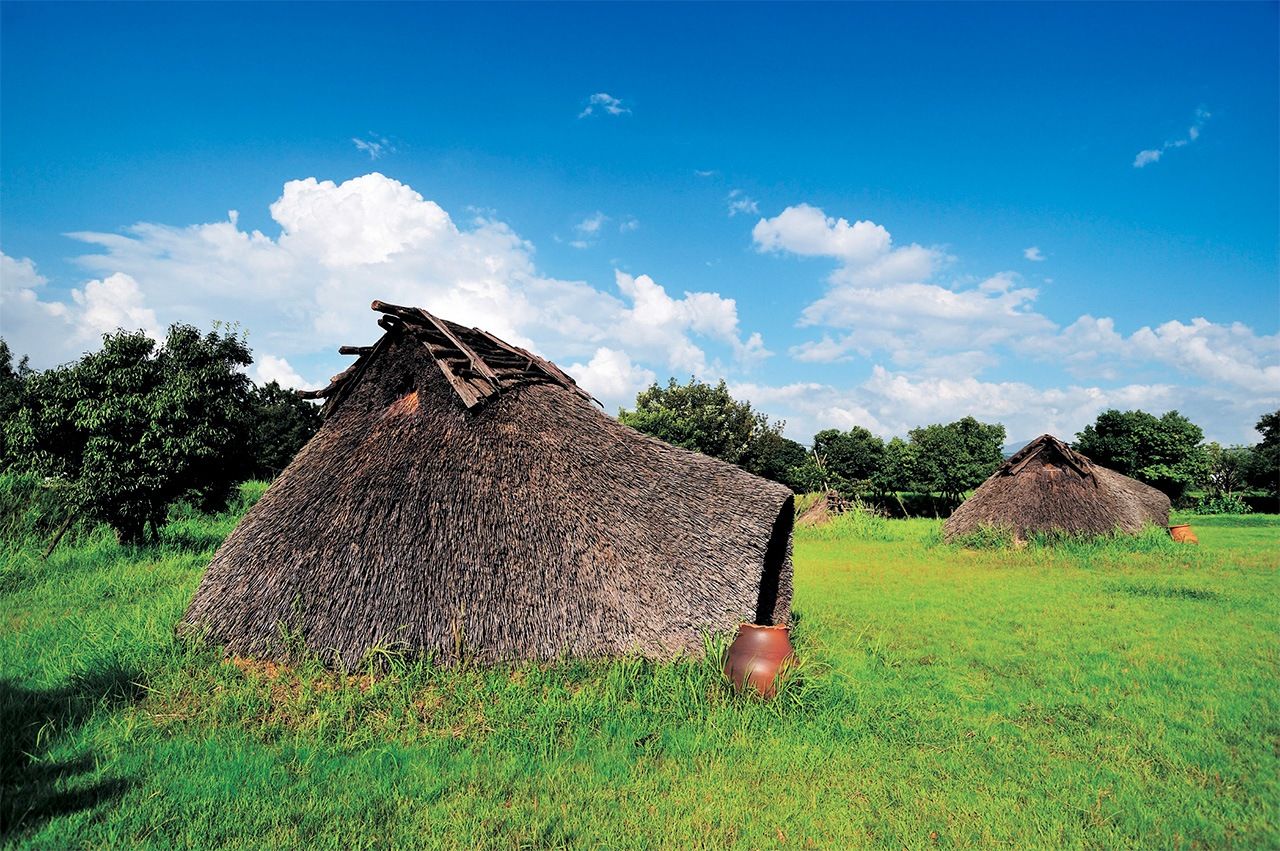
The remains of Yayoi period (ca. 300 BCE–300 CE) rice paddies were discovered at the Itazuke ruins. (© City of Fukuoka)
The King of Nakoku Gold Seal, a national treasure, signifies the beginning of diplomatic relations with China by the local ruler of the time. According to the Treatise on the Dongyi, a volume of the Chinese historical text Book of the Later Han, in 57 CE Emperor Gwangwu gave a seal and cordon (believed to be a reference to the Gold Seal) to a vassal of Wa no Nakoku. The current archaeological consensus is that this is a reference to the Nakoku state on the shores of Hakata Bay.
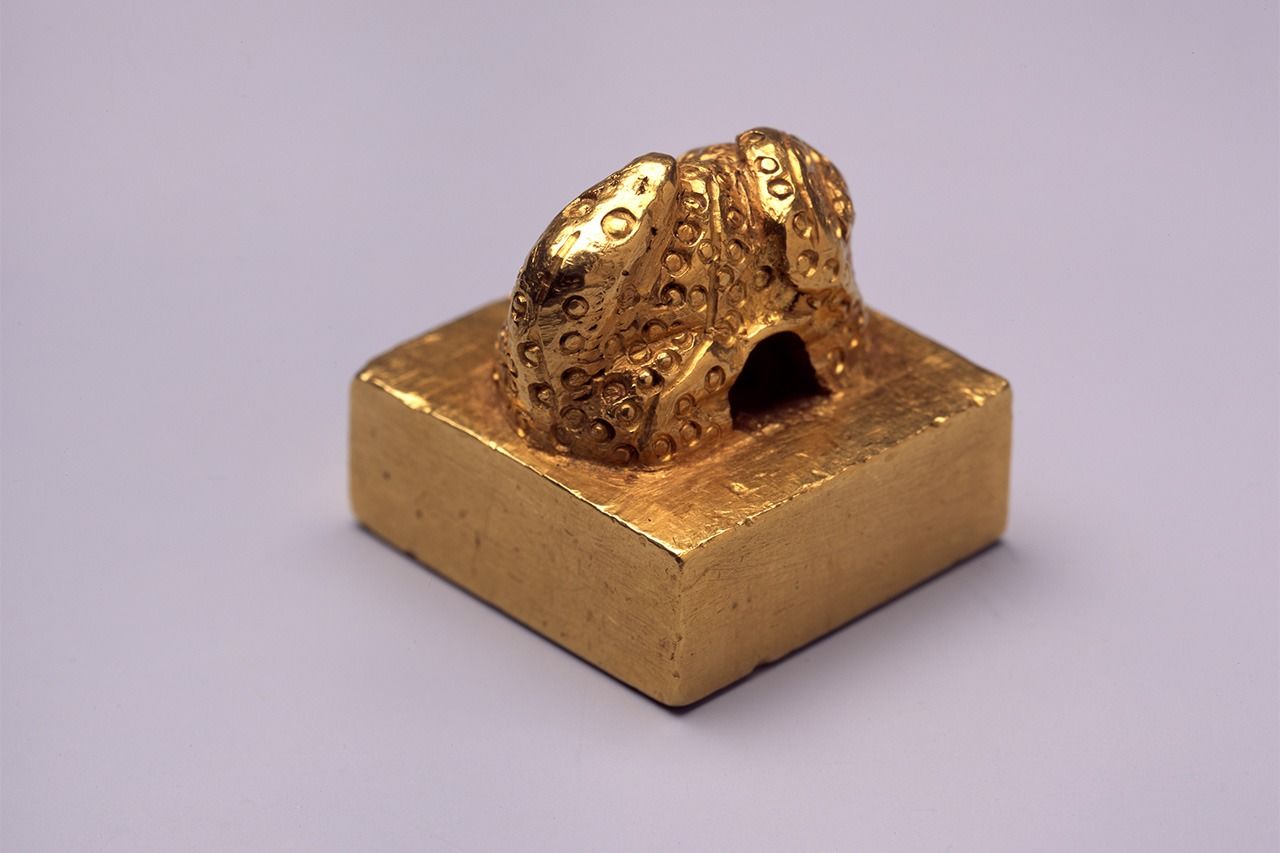
The King of Nakoku Gold Seal was discovered in 1784 in Shikanoshima. (© Fukuoka City Museum)
For the later Han, the visitation of envoys from afar after peace had been restored was a happy occurrence that expressed the virtue of the emperor. Nakoku exercised diplomacy with an understanding of the situation on the continent. Established by no later than the first century BCE, Nakoku is believed to have survived into at least the third century CE. Central Nakoku is believed to correspond to an area in modern day Fukuoka that spans from Hakata-ku to the neighboring inland city of Kasuga. Nakoku may therefore be described as the origins of a 2,000-year-old city.
In the Heian period (794–1185), Fukuoka’s diplomatic functions were performed in a building called the Kōrokan, under the governance of the central regime in the kinai, the capital region around what is now Kyoto and Nara. The Kōrokan fell under the jurisdiction of Kyūshū’s regional government, the Dazaifu, and was used to entertain envoys and merchants from overseas. The Kōrokan was also the place from which envoys and Buddhist priests bound for Tang dynasty China set off. Even after the practice of sending envoys to China was discontinued, the Kōrokan maintained ties with foreign merchants, and went from being a hub for diplomacy to a trading center. The goods brought by these traders were referred to as karamono, and were highly prized by the Japanese. Luxury goods indispensable to the imperial court, these karamono also had a great impact on Japanese culture.
Altogether, the Kōrokan in its various roles served as the frontline of foreign diplomacy and trade in ancient Japan for a total of 400 years, from the second half of the seventh century until the first half of the eleventh century. If we consider Japan to be the easternmost point on the Silk Road, Hakata Bay was its initial gateway.
The Golden Days of Trade
In the latter half of the eleventh century, the Kōrokan finally ceded its role as a center for trade to the city of Hakata. Trade was the domain of Song merchants living in Hakata, and the district in which they lived was referred to as the Hakata Tōbō—Japan’s first Chinatown. Hakata bustled with Song maritime merchants, Japanese merchants, and artisans, as karamono were taken to Kyoto and the Kamakura home of the shogunate, where they were highly prized. It was also these Chinese traders who supported the construction of Zen temples, and they increasingly lived among the Japanese.
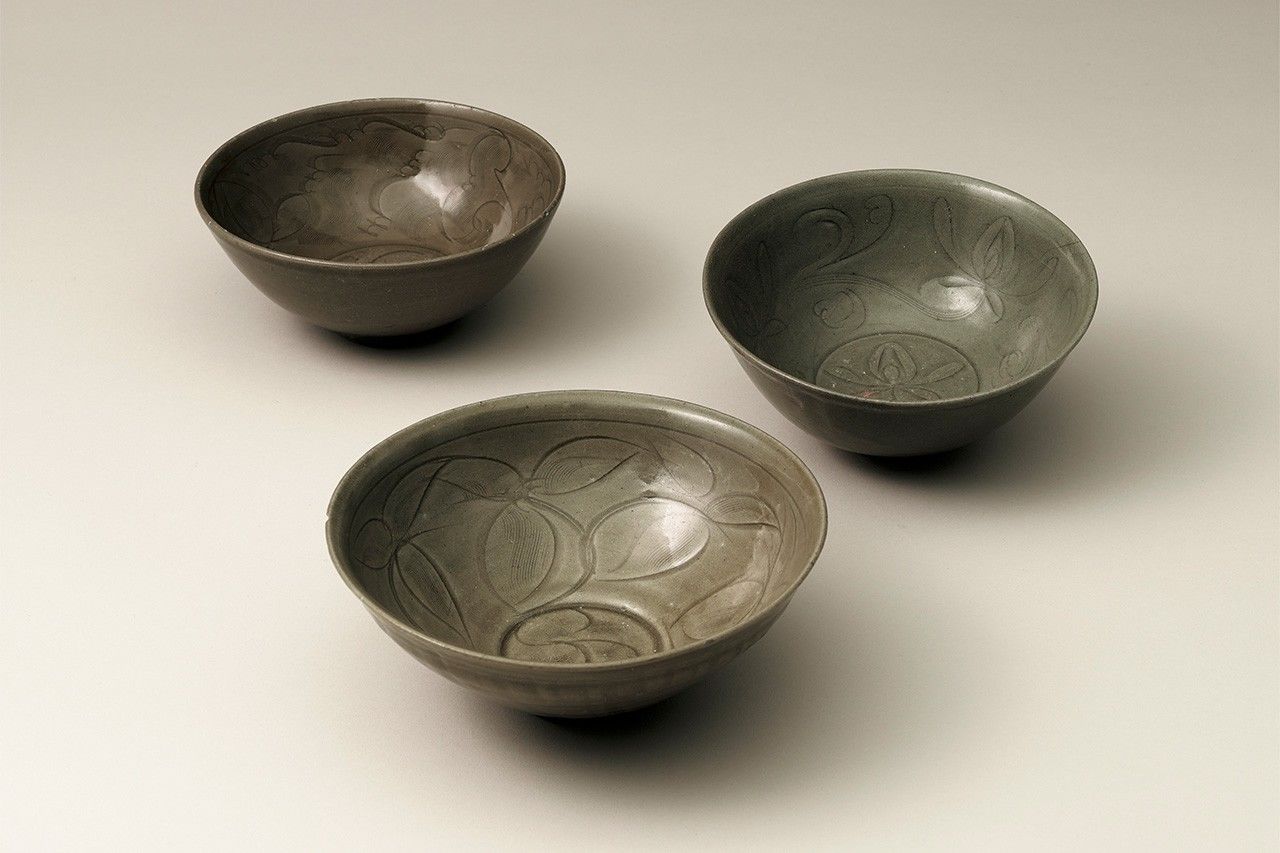
Porcelain unearthed from the Hakata ruins. These pieces were fired during the late Southern Song dynasty, in the kilns of Longquan, from the latter half of the thirteenth century through the first half of the fourteenth century. (© Fukuoka City Archaeology Center)
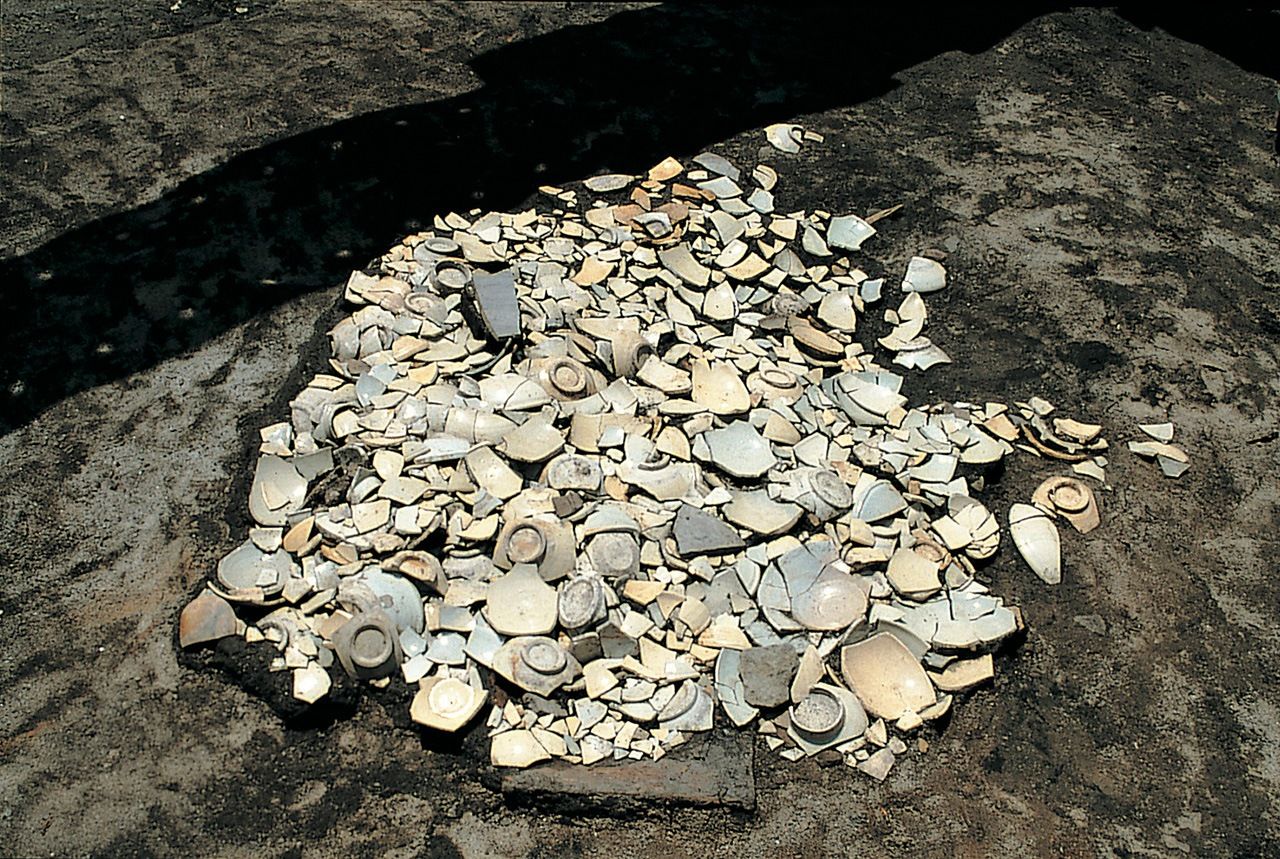
This broken white porcelain was excavated from a Hakata dig site and is believed to have dumped by traders upon landing. (© Fukuoka City Archaeology Center)
The Yuan dynasty, the Mongolian kingdom established on the continent, waged two attacks on northern Kyūshū as part of the Mongol invasions of Japan, both of which targeted Hakata Bay. These attacks took place in 1274 (Bun’ei no Eki) and 1281 (Kōan no Eki). After the Bun’ei no Eki, a stone wall was constructed along the Hakata Bay coastline Genkō bōrui, or anti-Mongolian bulwark; after the Kōan no Eki, an agency of the Kamakura shogunate known as the Chinzei Tandai was established, and it changed Hakata into a political city.
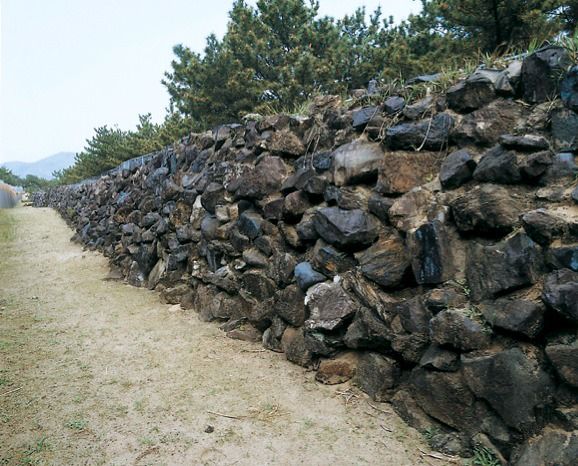
Part of the anti-Mongolian bulwark standing in Iki no Matsubara. (© City of Fukuoka)
After the Mongolian invasions, trading ships continued to travel between Hakata and Ningbo in China and Goryeo on the Korean peninsula. Even after the downfall of the Kamakura shogunate in 1333, Hakata continued to prosper on the back of trade with Ming China, Korea, and the Ryūkyū kingdom. The town’s major merchants also traded actively, and are said to have enjoyed a golden age from the eleventh century until the sixteenth century.
However, widespread unrest during the period of the Northern and Southern Dynasties (1336–92) and the tumultuous Warring States period (1467–1568) saw Hakata frequently ravaged by war. Of the various disputes that arose between prominent feudal lords, or daimyō, regarding the control of Hakata at the end of the Warring States period, the torching of the city in 1580 was a particularly devastating blow.
In 1587, Toyotomi Hideyoshi rebuilt Hakata from the ashes. Known as the Taikō-machiwari, Toyotomi’s reconstruction campaign laid the foundations for the urban district of modern-day Hakata.
Becoming the Biggest City in Kyūshū
Kuroda Nagamasa, who earned a name with his distinguished military service in the 1600 Battle of Sekigahara, was bequeathed Chikuzen province by Tokugawa Ieyasu. Nagamasa built a castle west of Hakata (modern-day Chūō-ku), and named the area Fukuoka after Bizen Fukuoka (the modern day Okayama prefecture), a region with which the Kuroda clan had links. It was thus that the twin cities of Fukuoka, a castle town, and Hakata, for centuries a major commercial center, came into being.
The historic Fukuoka and Hakata are both contained within modern Fukuoka, which officially became a city in 1889, although its area at that time was only 1.5% of its current size. The distinction between Fukuoka and Hakata remains evident today in festivals and customs.
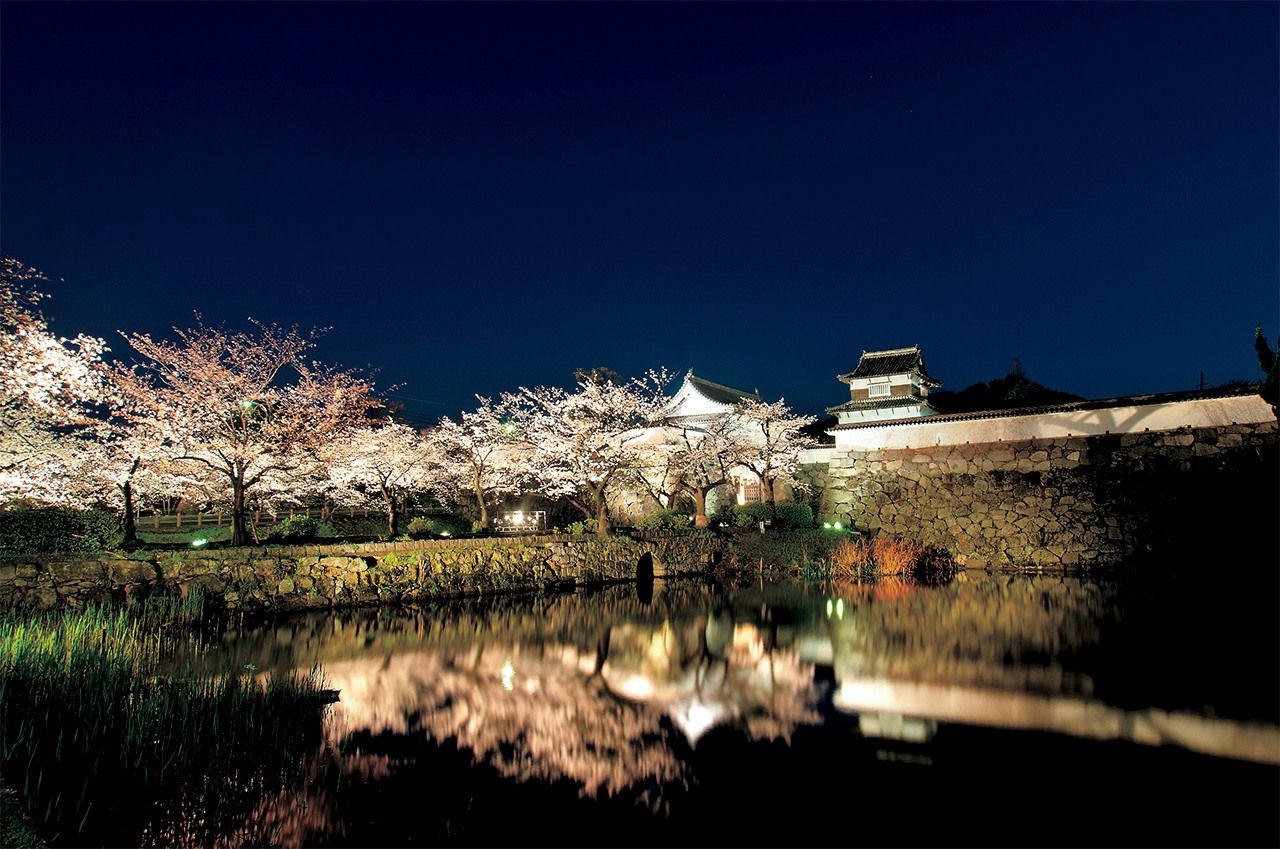
The remains of Fukuoka Castle. The remains of the Kōrokan are also on the grounds. (© City of Fukuoka)
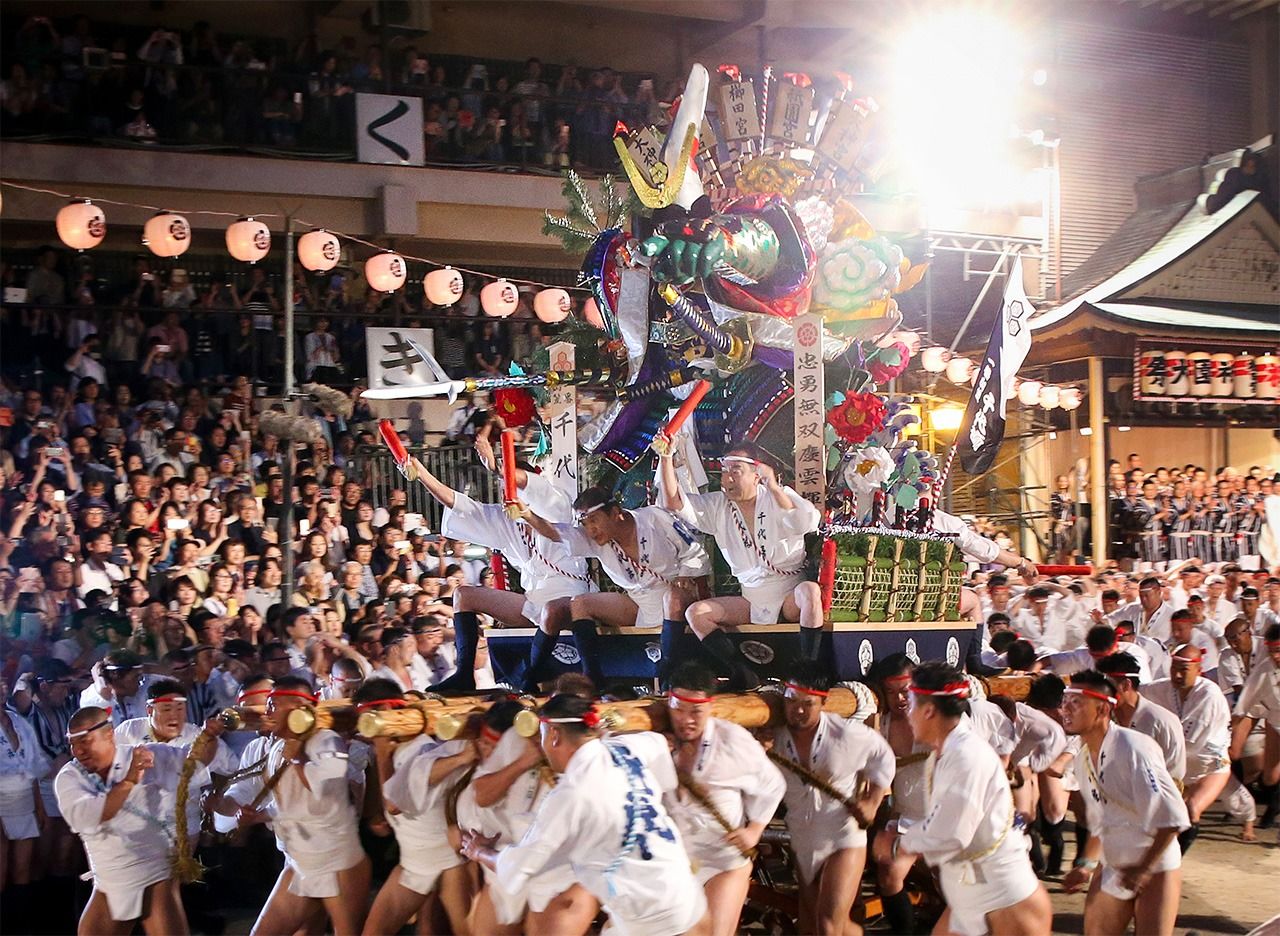
The Hakata Gion Yamakasa festival. This procession, known as the oiyama, begins in the small hours of the morning and climaxes with a finale. Taken on July 15, 2019. (© Jiji)
After becoming an official city, Fukuoka would go on to win out against stiff competition and became the largest metropolitan area in Kyūshū. At the city’s dawn, though, when Japan was embarking on the process of modernization, the largest city in Kyūshū was Nagasaki, a city that was directly controlled by the Edo shogunate and was the sole point of contact with the outside world. In terms of population, too, Fukuoka fell behind Kagoshima, which played a leading role in the Meiji Restoration, as well as Kumamoto, a castle town ruled by the prominent Hosokawa clan. The northern Kyūshū cities of Yahata, which led the region in industrialization as the location for a state-run steel mill, and Moji, which prospered as the northern terminal for the Kyushu Railway and as a seaport city, were all examples of successful modern cities in the history of Kyūshū’s modernization.
The first major driver of Fukuoka’s urbanization was the Kyūshū-Okinawa Eight Prefectures Confederated Exhibition of 1910, which can be described as regional Japan’s version of a national industrial exposition. The exhibition saw the establishment of transport infrastructure, including street railways. This was followed by the relocation to Fukuoka of Kyūshū Imperial University, and the city’s transformation into a modern consumer center in the 1920s and 1930s, with the result that Fukuoka grew into a metropolis boasting the largest population in Kyūshū.
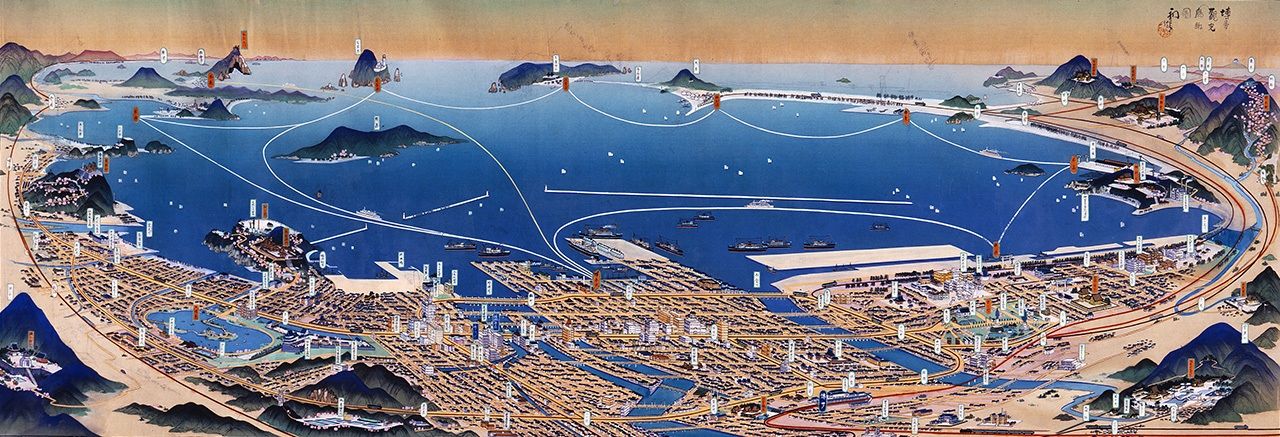
Yoshida Hatsuzaburō’s Hakata kankō chōkan zu (Bird’s-Eye View of Destinations in Hakata) was commissioned by the Hakata Chamber of Commerce for a 1936 exhibition on the construction of Hakata Harbor. (© Fukuoka City Museum)
Even in the years following the end of the Second World War, however, Fukuoka had yet to realize its dream of becoming a dynamic industrial city like the other cities in northern Kyūshū. It was not until the latter half of the 1960s that Fukuoka switched to a “control center” approach to urban planning and pursued development by accumulating tertiary industries. The shift in consumer focus from physical goods to experiences or events has also aided Fukuoka’s transformation, as the city enjoys its status as a mecca for startups with links to Asia.
Historical Facts Uncovered in Archaeological Digs
This is a city that refined the technique of rice cultivation in paddies that came to Japan from the continent, in which the concentration of the population gave rise to regal powers, and in which the movement to develop the area into a dense urban space has continued to build continuously in the relatively compact area that is the Fukuoka plains. It is as if the city is repeatedly overwriting its own past.
Development in the modern age is also a type of overwriting. However, overwriting the past does not necessarily involve erasing it. For example, in the Hie/Naka archaeological sites (Hakata-ku) alone, over 300 excavations have been undertaken, giving us a better idea of what Nakoku was like. For a long time, most of the substantive historical information that existed on the Kōrokan was gleaned solely from ancient texts, but in 1987, an archaeological survey performed as part of the renovation of the Heiwadai baseball stadium unearthed the entirety of the Kōrokan ruins, now a nationally designated historical site.
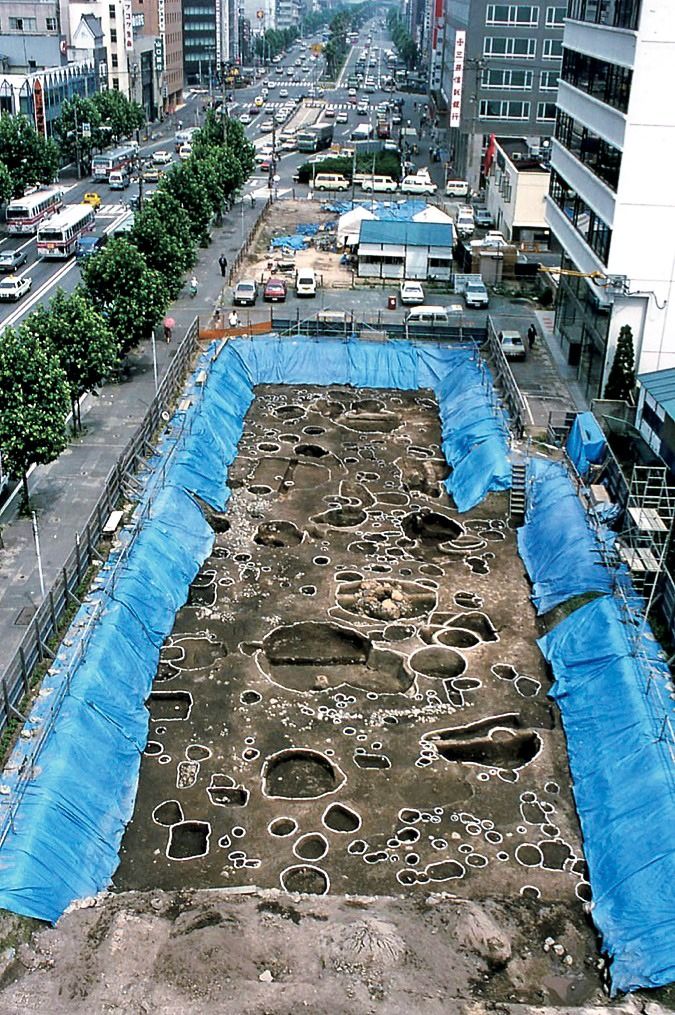
In an archaeological survey of this city-center site, layers corresponding to the early modern period down through the middle ages were excavated. (© Fukuoka City Archaeology Center)
The Hakata archaeological survey, which began in 1977 as part of the construction of Fukuoka’s subway system and is ongoing today, has uncovered ruins, large amounts of imported porcelain, and other artifacts that have revealed in great detail how the international trading city of Hakata, which had been described in ancient texts, actually looked. Of the more than 300,000 artifacts unearthed, 2,138 were designated national important cultural properties in 2017.
(Originally published in Japanese. Banner photo: Fukuoka from the air. The high-rise buildings are situated on reclaimed land in an area that was developed ahead of the 1989 Asia-Pacific Expo. © City of Fukuoka.)